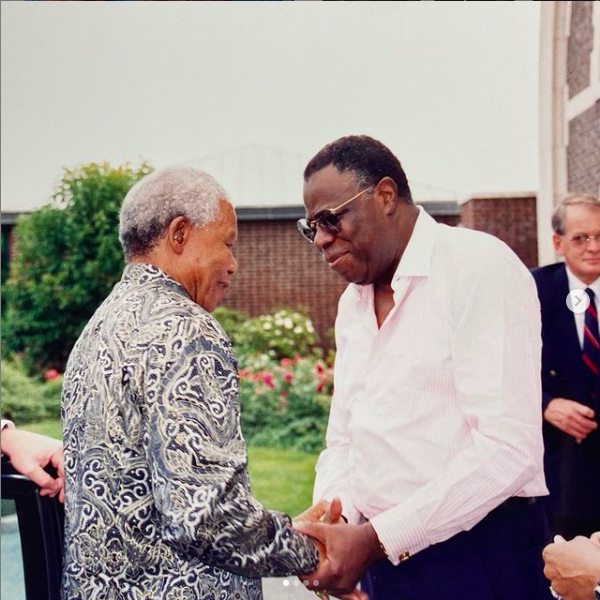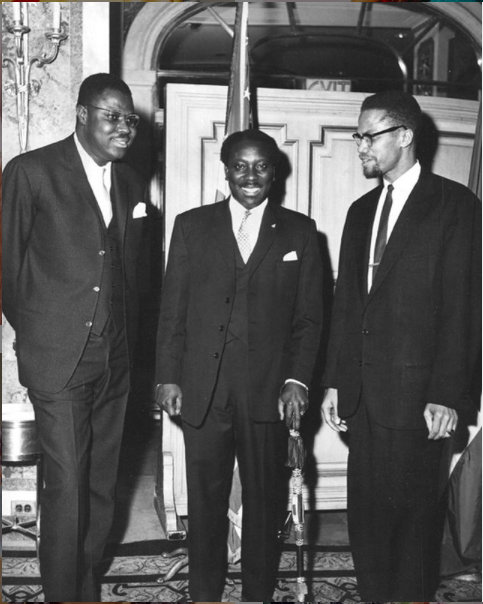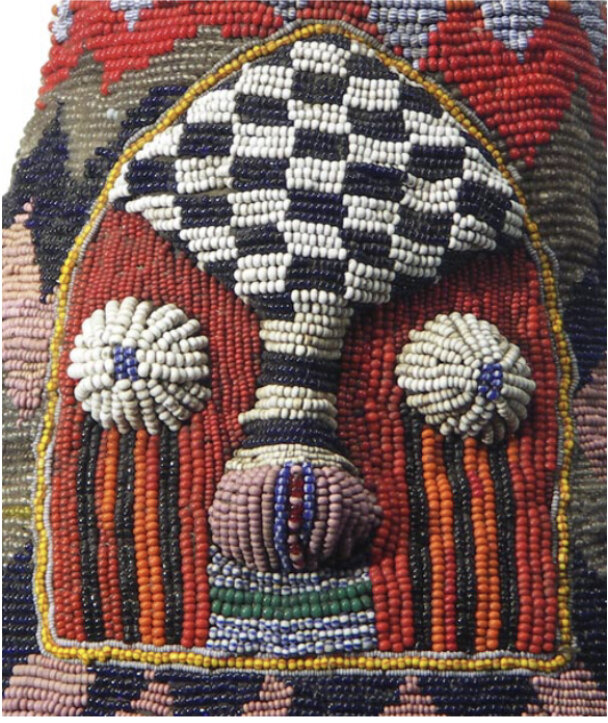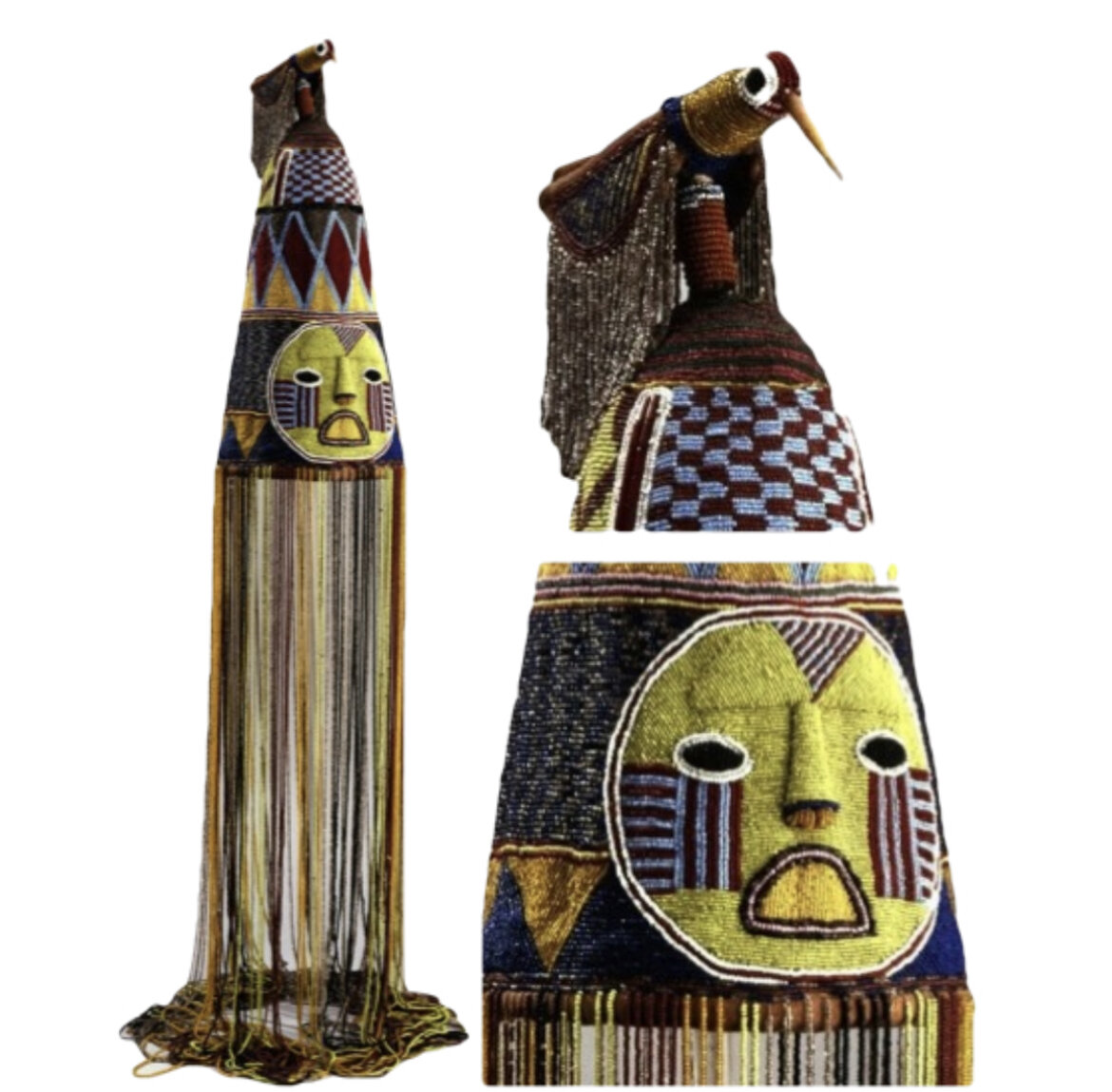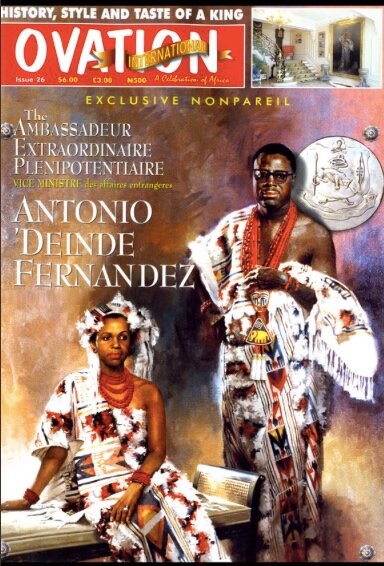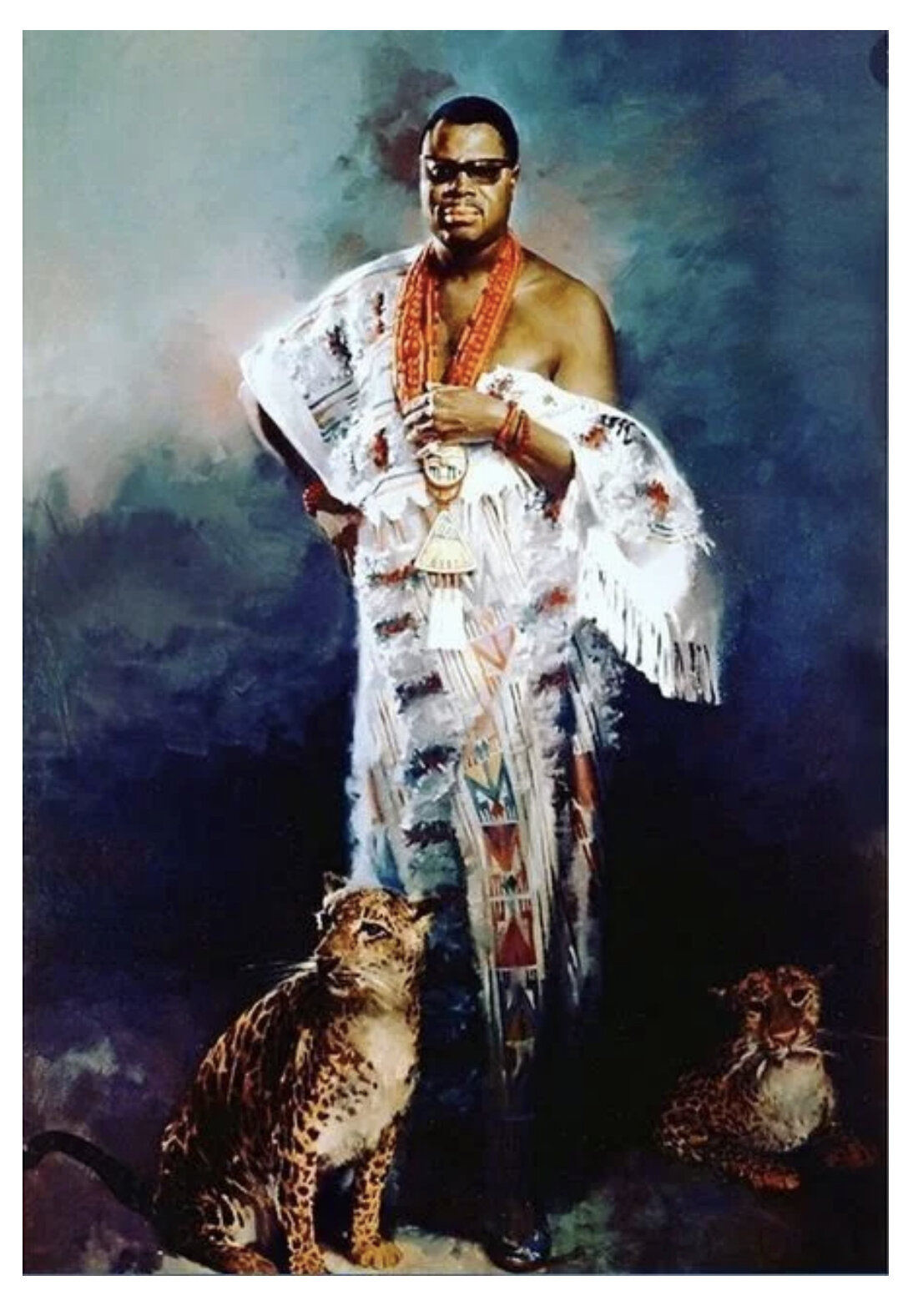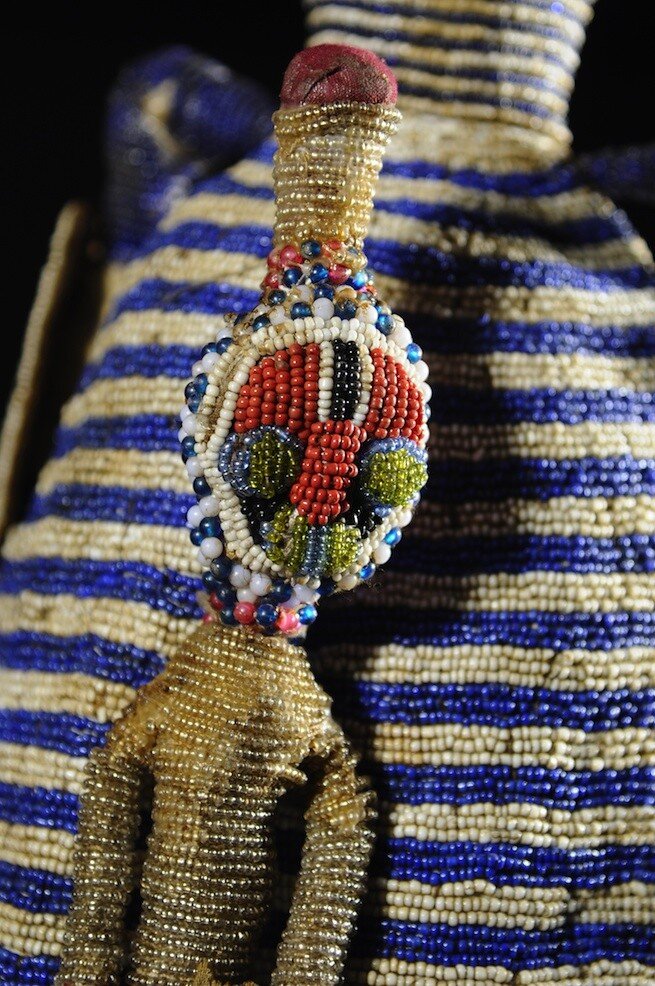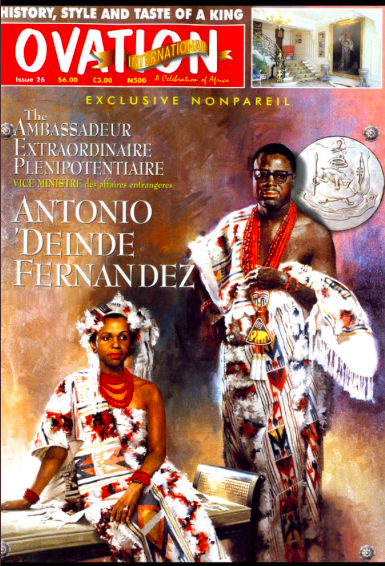Dessin gouaché sur calque, commande spéciale




Dessin gouaché sur calque, commande spéciale
Dessin gouaché sur calque représentant un long collier de perles de corail centré d'un motif de masque africain - de culture Yoruba- pensé pour être réalisé en diamants, rubis, saphirs, rubis, perles, perles de corail et de jade néphrite. Dans un encadrement et passe-partout précisant " Specially designed by Cartier Ltd for Chief A.O. Fernandez (for Antonio Oladeinde Fernandez 1929-2015).
Circa 1973-1975
H 75,5 x L 36,2 cm.
Bon état général
En partenariat avec Diamantiques
Gouache drawing on tracing paper representing a long necklace of coral beads centered with an African mask motif - of Yoruba culture - thought to be made of diamonds, rubies, sapphires, pearls, coral beads and nephrite jade. In a frame and passe-partout stating "Specially designed by Cartier Ltd for Chief A.O. Fernandez (for Antonio Oladeinde Fernandez 1929-2015).
Circa 1973-1975
H 75,5 x W 36,2 cm.
Good condition.
In partnership with Diamantiques
« Il ne peut être question de jouir des droits de l'homme dans une situation de conflit »...
« Alors que nous définissons et affinons les responsabilités de notre Organisation en matière de maintien de la paix, qui, de l'avis général, s'entend désormais dans son sens le plus large, à savoir la prévention, la gestion et la résolution des conflits, soyons toujours conscients que la jouissance universelle des droits de l'homme, l'une des aspirations majeures de l'humanité, ne peut être et ne sera pas atteinte si nous ne consacrons pas autant d'efforts à l'élimination des conditions qui provoquent la violation de ces droits. » Extraits de discours de A. O. Fernandez aux Nations Unies
Cet homme né en 1929 au Nigeria descend d’une famille d’esclaves affranchis du Brésil, qui comme Le Nigéria fut colonisé par les Portugais. Le nom de Fernandez en est un stigmate et il est répandu dans la capitale, Lagos; de ce nom sont signés de nombreux bâtiments modernes dans un style brésilien spectaculaire.
Antonio Oladeinde Fernandez quitte le Nigeria jeune afin e suivre des études dans les universités de Cambridge (GB) puis de Columbia (US) avant d’embrasser une carrière dans les affaires et diplomatie. Il est souvent cité avec le titre de chef au sens honorifique traditionnel lié à la vie de village1 et il a reçu d’innombrables autres distinctions des Etats dans lesquels il a officie.
Dès le début de sa carrière, il noue des liens forts et intimes avec des chefs d’Etat et leaders politiques tels que MM. Nelson Mandela, Kofi Annan, Mobutu, Jimmy Carter, George Bush père, il rencontre même Malcolm X, à New York où il habite avec sa famille.
Son excellence, Oluwo Antonio Oladeinde Fernandez, fait des dépenses somptuaires tout en conservant une certaine forme d’anonymat et de discrétion aux yeux du grand public et les informations à son sujet sont très rares. Il possède de nombreuses propriétés de New York à Lagos en passant par un château en France et il a à peine le temps de séjourner dans chacune. Lorsqu’il se rend au restaurant, il préfère simplement le privatiser et il possède plusieurs jets privés. Ses activités sont situées dans un environnement panafricain, mais il est très peu impliqué dans les activités mêmes du Nigéria. Sa fortune est supposée provenir de ses participations dans des sociétés pétrolières en République centrafricaine, ainsi que dans des sociétés d’extraction de bauxite, d’or et de diamant en Angola et ailleurs.
Ses fonctions diplomatiques sont nombreuses et révèlent une présence essentielle dans des pays d’Afrique voisins du Nigeria, ou anciennement liés au Portugal.
Il a été consul de la République du Bénin (alors République du Dahomey) en 1966, puis conseiller économique du gouvernement angolais en 1982, proche du président José Eduardo dos Santos élu depuis 1979.
En 1984, il a été nommé ambassadeur et représentant permanent adjoint du Mozambique auprès des Nations unies, il a été vice-ministre des finances au Swaziland, conseiller spécial du président du Mozambique pour les questions économiques internationales et, de 1992 à 1995, ambassadeur itinérant pour la République du Togo et l'Angola
Bien que nigérian, il est nommé représentant permanent de la République centrafricaine (RCA) aux Nations unies en 1997
La devise familiale de ce chef Yoruba - qui serait l'un des membres les plus éminents de la confrérie Ogboni 2 - était Aguntan meji kii mumi ninu koto kan na, deux béliers ne peuvent boire dans la même auge.
La culture Yoruba est propre à une ethnie issue de l’Afrique de l’Ouest, et dont les influences s’étendent à plusieurs pays et à différents continents en raison des déplacements de population des à la traite négrière. Celaa donné lieu à une importante diaspora de l’autre côté de l’Atlantique, notamment aux Etats-Unis, à Cuba et au Brésil.
À l’origine, le peuple Yoruba est principalement présent au Nigeria, sur la rive droite du fleuve Niger, mais aussi au Bénin, au Ghana, au Togo ainsi qu’en Côte d’Ivoire (où il est appelé Anango.)
Son décès soudain en 2015 est l’occasion de recherches à son propos, elles sont relatées dans les quarante pages que lui consacre le magazine Ovation International dirigé par le nigerian en exil Chief Dele Momodu et fondé à Londres en 1996.
C’est dans ce contexte d’affaires et de diplomatie que s’inscrivent de grandes commandes et un train de vie de chef d’État pour Antonio D. Fernandez et sa famille. Le collier dessiné par la maison Cartier s’inscrit dans ce contexte. Il s’agit d’une proposition préparatoire, très proche du modèle définitif réalisé pour leur commandiataire.
Des échanges ont eu lieu afin de décider des modalités de la création dans les ateliers de Londres de la prestigieuse maison de joaillerie. Ce calque sur lequel le collier est présenté à l’échelle 1 ou très proche de la réalité est destinée à donner au commanditaire l’idée la plus précise de ce qui sera réalisé et du placement exact des pierreries. Ce gouaché est une étape de la réalisation du collier qui existe encore aujourd’hui avec une exacte correspondance visible dans le portrait officiel peint. Il présente trois rangs de corail terminés par des perles fines en pampilles.
A propos de la pratique de dessin gouaché en joaillerie
Ansi l’on reconnaît dans cette commande le caractère somptueux de la demande pour réaliser un collier d’apparat et de chef.
Il est centré sur une représentation de masque stylisé très proche de la tradition des coiffes perlées Yoruba à motifs de têtes.
Les traditionnelles perles de verre sont ici remplacées par une liste de pierres de couleur taillées les plus précieuses telles que les rubis, saphirs et émeraudes alliés à l’éclat du diamant sur une monture en or jaune et entourées de corail et jadéite. Ces choix exubérants ne manquent pas de rappeler les activités de l’homme d’affaires autant que son goût du luxe. Un portrait d’apparat a été commandé par la suite et il y est représenté dans une toge portant deux colliers emblématiques de sa volonté de s’inscrire dans une lignée de portraits de chefs ; entouré de deux léopards domestiqués à ses pieds, ils symbolisent sa force et sont aussi une expression de l’importance de son titre de Grand Officier de l'Ordre National du Léopard attribué par la République démocratique du Congo.
Une version alternative de cette représentation a été publiée en couverture du numéro spécial que lui dédie la revue Ovation International; Dans ce double portrait, les léopards sont remplacés par son épouse assise sur une banquette en contrebas de lui debout et valeureux.
Marié et divorcé de plusieurs femmes, ses neuf enfants vivent aujourd’hui dans une certaine discrétion excepté sa fille Abimbola, surnommée Bim qui a tenté une carrière musicale et de mannequins tandis qu’un autre fils est DJ.
1 un chef traditionnel est défini comme « n’importe quelle personne qui, selon le droit coutumier de la communauté traditionnelle concernée, détient une position traditionnelle dominante, et est reconnue par la loi » selon la Constitution de l’Afrique du Sud
2 d’après le livre « The sociology of the Yoruba » de Nathaniel Akinrẹmi Fadipẹ, l’analyse rapportée de Olympe Bhêly-Quenum du chapitre «Economic Organisation» of the Yoruba people révèle des faits significatifs hors du commun; ceux qui méritent d’être soulignés concernent la société secrète Ogboni et les esclaves; les luttes d’Ogboni contre le colonialisme et son entrisme ne sont pas absents des livres des écrivains yoruba tels qu’Amos Tutuola et Wole Soyinka; d’autre part, ne devient pas Ogboni qui veut: il faut être Yoruba par filiation patrilinéaire; des considérations assez complexes surgissaient dans le cas de filialité matrilinéaire parce que les normes de la société secrète excluaient l’initiation d’un étranger; ce qui frappe dans ce chapitre en en faisant la singularité est le processus d’admission d’esclaves méritants, qui, ayant acheté leur liberté «buy their freedom» grâce aux possibilités offertes par leurs Maîtres ou par leurs propres entregents, devenaient des hommes libres; un dignitaire Ogboni «owner» (propriétaire) d’un esclave devenu homme libre pouvait, eu égard aux qualités humaines, à la formation, à l’attachement pour Egbaland de ce dernier, lui proposer d’être Ogboni! Fadipẹ note des cas d’anciens esclaves employés dans des secteurs socio-économiques qui ont accédé à des rangs de dignitaires et exercé de hautes fonctions dans cette confrérie très fermée.
Sources
https://thenationonlineng.net/anthony-oladeinde-fernandez-1929-2015/
https://en.wikipedia.org/wiki/Antonio_Deinde_Fernandez
https://www.forbes.com/sites/carriecoolidge/2018/01/09/live-like-a-billionaire-in-this-waterfront-mansion-in-new-york/?sh=3d97321efe87
"There can be no question of enjoying human rights in a situation of conflict"...
"As we define and refine the responsibilities of our Organization in peacekeeping, which is now generally understood in its broadest sense, namely the prevention, management and resolution of conflicts, let us always be aware that the universal enjoyment of human rights, one of the major aspirations of mankind, cannot and will not be achieved unless we devote equal effort to the elimination of the conditions which cause the violation of these rights. "Excerpts from A.O. Fernandez' speech at the United Nations
Born in 1929 in Nigeria, Fernandez is descended from a family of freed slaves from Brazil, which like Nigeria was colonized by the Portuguese. The name Fernandez is a stigma and is prevalent in the capital city of Lagos; many modern buildings in a spectacular Brazilian style are signed with this name.
Antonio Oladeinde Fernandez left Nigeria at a young age to study at Cambridge University (UK) and Columbia University (US) before embarking on a career in business and diplomacy. He is often cited with the title of Chief in the traditional honorific sense of village life1 and has received countless other honors from the states in which he has served.
From the beginning of his career, he has developed strong and intimate relationships with heads of state and political leaders such as Nelson Mandela, Kofi Annan, Mobutu, Jimmy Carter, George Bush Sr., and even Malcolm X, in New York where he lives with his family.
His Excellency, Oluwo Antonio Oladeinde Fernandez, spends lavishly while maintaining a certain form of anonymity and discretion in the eyes of the general public, and information about him is very rare. He owns numerous properties from New York to Lagos to a chateau in France and barely has time to stay in each one. When he does go to a restaurant, he prefers to simply privatize it and he owns several private jets. His activities are located in a pan-African environment, but he has very little involvement in Nigeria's own activities. His fortune is believed to come from his holdings in oil companies in the Central African Republic, as well as in bauxite, gold and diamond mining companies in Angola and elsewhere.
His diplomatic functions are numerous and reveal a key presence in African countries neighboring Nigeria, or formerly linked to Portugal.
He was consul of the Republic of Benin (then Republic of Dahomey) in 1966, then economic advisor to the Angolan government in 1982, close to President José Eduardo dos Santos elected since 1979.
In 1984, he was appointed ambassador and deputy permanent representative of Mozambique to the United Nations, he was deputy minister of finance in Swaziland, special advisor to the president of Mozambique for international economic issues and, from 1992 to 1995, ambassador at large for the Republic of Togo and Angola.
Although a Nigerian, he was appointed Permanent Representative of the Central African Republic (CAR) to the United Nations in 1997
The family motto of this Yoruba chief - said to be one of the most prominent members of the Ogboni 2 brotherhood - was Aguntan meji kii mumi ninu koto kan na, two rams cannot drink from the same trough.
The Yoruba culture is specific to an ethnic group originating from West Africa, and whose influences extend to several countries and different continents due to the displacement of people by the slave trade. This gave rise to a large diaspora on the other side of the Atlantic, notably in the United States, Cuba and Brazil.
Originally, the Yoruba people are mainly present in Nigeria, on the right bank of the Niger River, but also in Benin, Ghana, Togo and Ivory Coast (where they are called Anango).
His sudden death in 2015 is the occasion for research on him, which is reported in the forty pages devoted to him by the magazine Ovation International directed by the Nigerian in exile Chief Dele Momodu and founded in London in 1996.
It is in this context of business and diplomacy that Antonio D. Fernandez and his family have received large orders and lived the life of a head of state.
The necklace designed by Cartier is part of this context. It is a preparatory proposal, very close to the final model made for their patron.
Exchanges took place in order to decide on the modalities of the creation in the London workshops of the prestigious jewelry house. This tracing on which the necklace is presented at scale 1 or very close to reality is intended to give the client the most precise idea of what will be achieved and the exact placement of the stones. This gouache is a step in the realization of the necklace that still exists today with an exact correspondence visible in the official painted portrait. It presents three rows of coral finished with fine pearls in tassels.
About the practice of gouache drawing in jewelry
Thus one recognizes in this commission the sumptuous character of the request to make a ceremonial and chief's necklace.
It is centered on a representation of a stylized mask very close to the tradition of Yoruba beaded headdresses with head motifs. The traditional glass beads are replaced here by a list of the most precious colored cut stones such as rubies, sapphires and emeralds combined with the brilliance of diamonds on a yellow gold setting and surrounded by coral and jadeite. These exuberant choices are a reminder of the businessman's activities as well as his taste for luxury. A ceremonial portrait was later commissioned in which he is depicted in a toga wearing two necklaces emblematic of his desire to follow in a line of portraits of chiefs; surrounded by two domesticated leopards at his feet, they symbolize his strength and are also an expression of the importance of his title of Grand Officer of the National Order of the Leopard awarded by the Democratic Republic of Congo.
An alternative version of this depiction was published on the cover of the special issue of Ovation International magazine dedicated to him; in this double portrait, the leopards are replaced by his wife sitting on a bench below him standing tall and brave.
Married and divorced from several women, his nine children now live in relative secrecy except for his daughter Abimbola, nicknamed Bim, who has attempted a career in music and modeling, while another son is a DJ.
1 a traditional leader is defined as "any person who, according to the customary law of the traditional community concerned, holds a dominant traditional position, and is recognized by law" according to the Constitution of South Africa.
2 from the book "The sociology of the Yoruba" by Nathaniel Akinrẹmi Fadipẹ, Olympe Bhêly-Quenum's reported analysis of the "Economic Organisation" chapter of the Yoruba people reveals some significant facts out of the ordinary; those that deserve to be emphasized concern the Ogboni secret society and the slaves; Ogboni's struggles against colonialism and its entryism are not absent from the books of Yoruba writers such as Amos Tutuola and Wole Soyinka; on the other hand, not everyone becomes Ogboni: one must be Yoruba by patrilineal descent; rather complex considerations arose in the case of matrilineal descent because the norms of the secret society excluded the initiation of a foreigner; What is striking in this chapter and makes it unique is the process of admission of deserving slaves, who, having bought their freedom through the opportunities offered by their Masters or by their own agents, became free men; a dignitary Ogboni "owner" of a slave who had become a free man could, in view of the latter's human qualities, education, attachment to Egbaland, propose him to be Ogboni! Fadipẹ notes cases of former slaves employed in socio-economic sectors who rose to the ranks of dignitaries and held high positions in this very closed brotherhood.
Sources
https://thenationonlineng.net/anthony-oladeinde-fernandez-1929-2015/
https://en.wikipedia.org/wiki/Antonio_Deinde_Fernandez
https://www.forbes.com/sites/carriecoolidge/2018/01/09/live-like-a-billionaire-in-this-waterfront-mansion-in-new-york/?sh=3d97321efe87

